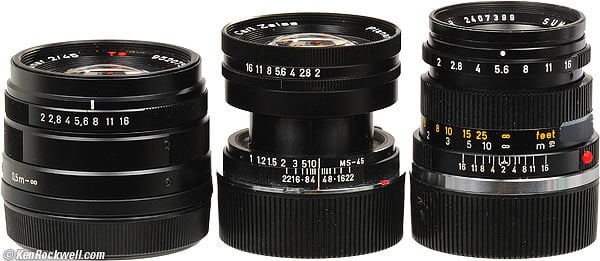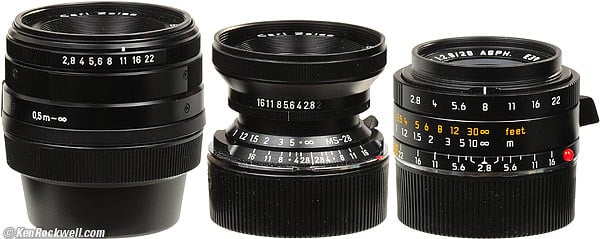Home New Search Gallery How-To Books Links Workshops About Contact
Contax G to Leica M
Lens Conversions
© 2009 KenRockwell.com. All rights reserved.
Intro Specs 28mm Performance 45mm Performance Recommendations
Contax G 45mm f/2, converted to Leica M, and Leica 50mm f/2 (1970). enlarge.
Contax G 28mm f/2.8, converted to Leica M, and Leica 28mm f/2.8 ASPH. enlarge.
It helps me keep adding to this site when you use these links to Adorama, Amazon, B&H, Calumet, Ritz, J&R and eBay to get your goodies. Thanks! Ken.
February 2009 Leica Camera Reviews Leica Lens Reviews
Recommended Leica Lenses Leica Lens Names
How to Afford Anything More Contax Reviews
Introduction top
Intro Specs 28mm Performance 45mm Performance Recommendations
|
I personally buy from Adorama, Amazon, Ritz, B&H, Calumet and J&R. I can't vouch for ads below.
|
What's going on here? What are the strange lenses in the middle of each row?
On the left we have perfectly wonderful Zeiss autofocus lenses for the Contax G system.
On the right, we have genuine German Leica lenses.
In the middle, we have the Zeiss for Contax G lenses which have been converted to the manual-focus Leica M mount.
I thought I was crazy spending so much time on Leica and the Contax G system, especially on comparing them, and then a reader sent me these two Contax G lenses he had converted for use on Leica M!
These conversions work on everything from the M3 of 1954 to today's M7, MP and M8.2, just like any other Leica M lens.
To get my personal bias out of the way, I'll admit that I'm always impressed when I come across people even crazier than I am. I wouldn't do this to any of my Contax lenses because I shoot them on my G2, and I'd rather use real Leica lenses on my Leica, but I always have respect for people who can pull off a good conversion like this.
It seems crazy to me to take a perfectly wonderful Contax G autofocus lens and discombobulate it to fit the klunky manual focus Leica cameras, but if someone does it, I'm all eyes and ears.
These conversions really work. If you want to shoot the Contax G lenses on your Leica, have at it.
All the optics and images are unsurpassed, but neither conversion looks or feels as good as the original Contax lenses, which don't feel as nice as the Leica lenses.
These are hand-made conversions. They are among the very best conversions I've ever seen, but they are nowhere near as nice as the original lenses. This is what happens with conversions; these aren't factory products.
Specifications with commentary top
Intro Specs 28mm Performance 45mm Performance Recommendations
28mm f/2.8 top
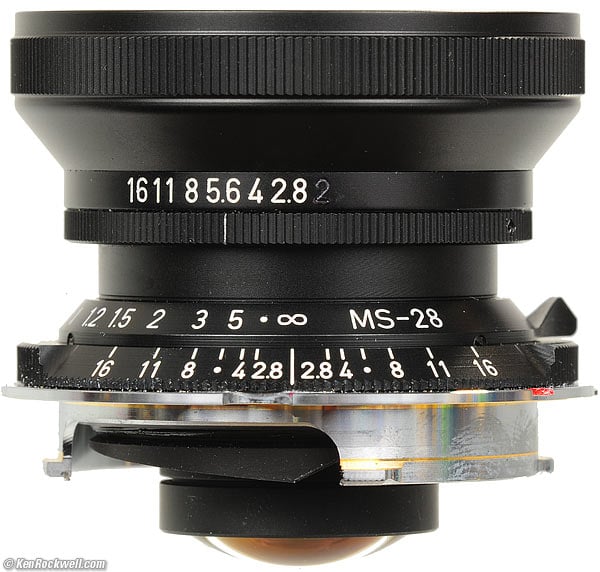
28mm f/2.8 Contax G converted to Leica M, enlarged.
28mm Specifications top
Conversion |
|||
| Filter Size | 46mm |
46mm |
39mm |
| Aperture Blades | 6 blades |
6 blades |
10 blades |
| Minimum Aperture, marked | f/22 |
f/16 |
f/22 |
| Close Focus, marked | 0.5m |
0.8m |
0.7m |
| Weight | 5.3 oz (150g) |
4.135 oz. (117.3g) |
6.107 oz. (173.18g) |
| Price |
45mm f/2 top
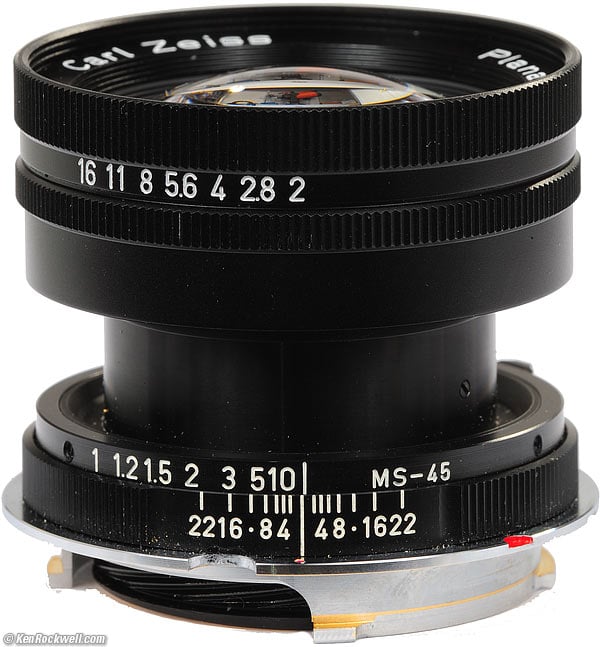
Contax G 45mm f/2 converted to Leica M, enlarged.
45/50mm Specifications top
Conversion |
Leica 50/2 (1970) |
||
| Filter Size | 46mm |
46mm |
39mm |
| Aperture Blades | 6 blades |
6 blades |
10 blades |
| Minimum Aperture, marked | f/16 |
f/16 |
f/16 |
| Close Focus, marked | 0.5m |
1m |
0.7m |
| Weight | 6.7 oz. (190g) |
5.025 oz. (142.5g) |
7.080 oz./200.7g |
| Price |
28mm Performance top
Intro Specs 28mm Performance 45mm Performance Recommendations
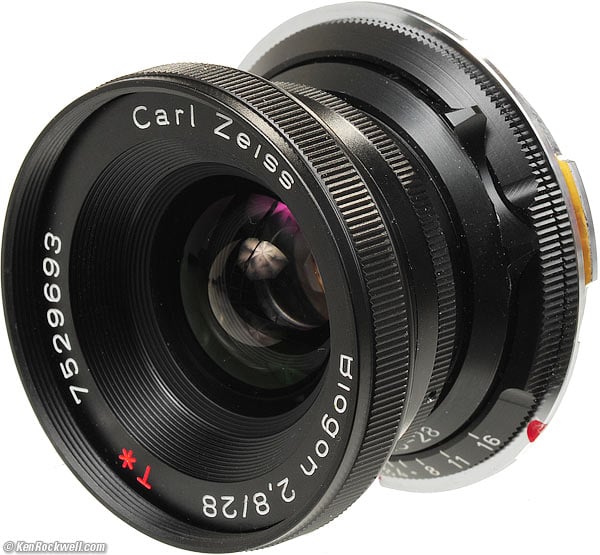
Contax G 28mm converted to Leica M, enlarged, showing focus tabs.
28mm Ergonomics top
The converted Contax lens doesn't feel anywhere near as nice at the Leica 28mm f/2.8 ASPH. The Leica is a work of ergonomic art, while the conversion is an obvious carefully hand-made kludge compared to a factory product. The conversion feels much worse than the native Contax G lens, which is also ergonomically quite sound.
Of course the conversion works great optically, it's the ergonomics which are klunky, but what do you expect, changing brands like this?
28mm Finder Blockage top
The Leica 28mm f/2.8 ASPH is so tiny that it doesn't block the 28mm finder of the M4-P, LEICA M6, M7 0.72 and MP, unless you use the hood.
This conversion is a bigger lens with a bigger filter thread, so it does block about a quarter of the lower right 28mm Leica finder, even without a hood.
Strange but true, the Contax G 28mm lens does not block the finder of the Contax G2 if you don't use a hood.
28mm Focus top
Focus on the Leica 28mm f/2.8 ASPH lens is a dream, with perfect damping, perfectly smooth operation and a perfect finger holder lever on the focus ring. The Leica has a hard and fast infinity stop; there's no question as to the location of infinity.
Focus on the Contax G lens is automatic with the G1 and G2. There is no focusing on the lens: even manual focus takes place on the Contax camera body.
The conversion has a nasty little pair of tabs that look like they're trying to imitate the big, fat Leica focus tab, but in fact feel more like two separate little pricks crammed inside a bunch of other lens hardware that interferes with the feel of focus.
The infinity stop of the conversion is mushy, and just as you're coming home to infinity, your finger hits something else on the lens barrel.
The Leica rangefinder won't couple down to 0.5m, and the mount isn't marked, however the conversion feels as it it will focus down to 0.5m (1.6 ft).
The focus scale is about the same length for each lens: you have to move the lens the same number of degrees to focus to any particular distance. The Leica lens' lever is longer than the little focus nubbins on the conversion.
The entire lens of conversion turns as you focus the lens. The filter thread, aperture ring and everything move together with the focus knob.
28mm Aperture top
It is difficult to set the aperture. It reminds me of the difficulty with many of Nikon's 1950's rangefinder lenses.
THe aperture ring is tiny little ring hidden in the middle of the lens.
Not only is it hard to find and turn, you have to hold the rest of the lens so that it doesn't turn in the focus mount as you're trying to set the aperture.
F/22 seems to be there, it's just not marked.
There are no click stops.
There is just a very tiny index on the aperture ring, and many very closely spaced aperture markings.
It's easy to set a precise aperture on any Leica lens, and less easy on a Zeiss-for-Contax lens, and nearly impossible on this conversion.
This could be a big negative if you use an external light meter and need precise settings, but no problem at all if you use a TTL meter as on the M5, LEICA M6, M7 and M8.
28mm Caps and Condoms top
Leica 28mm f/2.8 ASPH, Leica M conversion, and Contax G 28mm f/2.8. enlarge.
The original Leica and Contax lenses both protect the rear element. You can set either lens on a table (or concrete) and nothing happens.
The conversion does away with the two protective stands of the Contax lens, so please never set the converted lens down on its bottom, otherwise you'll grind down the glass.
The Contax has rear elements which protrude more than any current Leica lens.
Therefore you can't use the standard 14 269 Leica rear cap along with the rest of your Leica system. If you do, you'll not be able to jam it on with the conversion set to infinity. You have to set the conversion to a closer focus distance, or use a deeper cap. The lens I borrowed came with a recombobulated deeper Contax cap.
28mm Appearance top
This is of course very personal, but the conversion looks a lot uglier to me than either other lens.
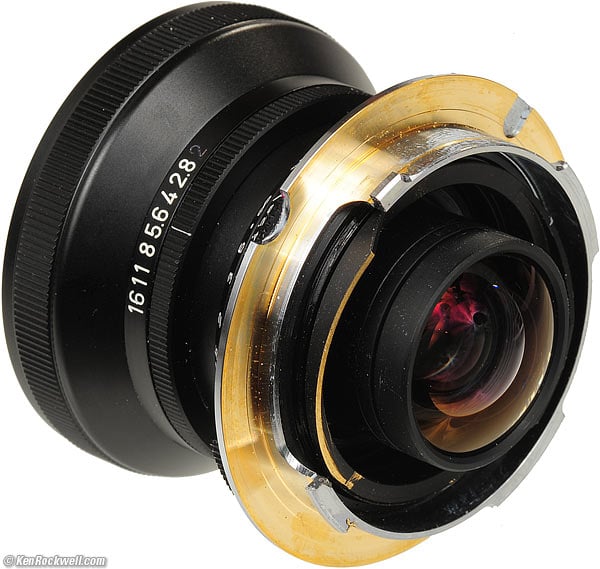
Rear of converted 28mm lens, enlarged.
28mm Optics top
If you want better optical performance, you should be shooting a larger format camera instead. You'll go go blind seeing any difference between these two.
You can see my separate Zeiss for Contax G 28mm and Leica 28mm f/2.8 ASPH Review for details. Either is as sharp a lens as I've ever used, and superior to every other 28mm lens I've used. Some Nikon SLR lenses are good, but even's Nikon's best (the f/2.8 AI-s and the f/1.4D) not as sharp in the corners and have more distortion.
You can see Zeiss' Contax data here and Leica's data here for MTF and distortion curves.
There is far more ergonomic difference than any optical difference between these lenses.
28mm Sharpness top
I'm not even going to go here. Either of these two lenses is as good as the 35mm format has ever seen.
If you're splitting hairs between these lenses, you're crazy, because they are each just about perfect. I can't see any difference at 40x.
Either is superior to anything else. They both just happen to be superb.
Nikon's 28mm f/3.5 for their 1950s rangefinder and the Nikon 28Ti lenses are dogs by comparison.
28mm Distortion top
The Contax has a little less distortion than the Leica, but neither has any visible distortion unless you're trying to measure it with instruments.
28mm Metering top
Metering works perfectly on my M7. The extra rear protrusion of the Contax lens helps it have a little less distortion than the Leica lens (whose distortion is invisible except with instruments anyway), but it's not enough of a protrusion to interfere with the meter.
The protrusion is spherical, so there's plenty of room for the light meter to see around it to see the white spot on the shutter curtains.
28mm Materials top
Everything seems like anodized aluminum with engraved and filled markings. The mount and helicoid appear to be brass.
Most of the converted mechanicals are more crude than the original Contax G lens. The conversion's edges are hard; not chamfered like Leica or Contax.
The mount is chromed brass, but oddly the chrome has been ground away to exposes bare brass at the mounting flange.
Bare brass should corrode with age. I suspect you'll reduce this if you coat it with a vapor-thin coating of Vaseline as recommended by Leica for their own lenses.
45mm Performance top
Intro Specs 28mm Performance 45mm Performance Recommendations
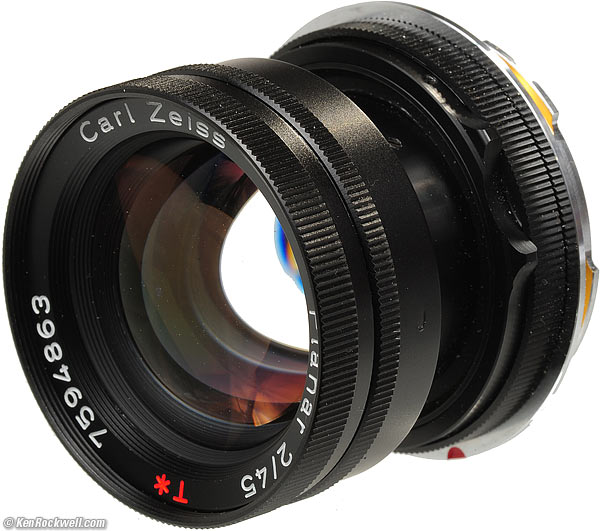
Contax 45mm G converted to Leica M, enlarged, showing focus tab.
45mm Ergonomics top
The conversion doesn't feel anywhere near as nice at the Leica 50mm f/2, and my 50mm f/2 is almost 40 years old.
The Leica lens works great, and so does the original Zeiss-for-Contax, but the conversion feels and looks like a kludge. The conversion feels much worse than the native Contax G lens, which is also ergonomically quite sound.
The conversion works great optically; it just doesn't feel like a factory product, which conversions aren't.
It does not collapse, even though the slim mid-section looks like early Leica lenses that did.
45mm Focus top
The focus damping is a little uneven.
Focus on the Contax G lens is automatic with the G1 and G2. There is no focusing on the lens: even manual focus takes place on the Contax camera body.
The conversion has a pair of tabs like the 28mm conversion, but the 45mm has another part of the lens body that interferes with your fingertip even more. It feels like a mistake compared to a Leica lens, but hey, I don't know of any better conversions that are any better either.
The focus scale is only marked to 1 meter, however it seems to focus at least to the close limit of your Leica's rangefinder, which is usually 0.7m.
The focus scale is much more cramped than any of the other lenses discussed here. A small movement of the focus ring causes about twice as much change in the rangefinder movement as the other lenses. You have to be more precise with your finger as you focus, but it also goes twice as fast as any other lens.
The entire lens barrel turns as you focus. The filter thread, aperture ring and everything move together with the focus knob.
The mount is hard on the fingers. The edges are much sharper than the chamfered edges of Leica lenses.
When I stick this conversion my Leica, the top of the lens isn't at the top; it's shifted somewhat.
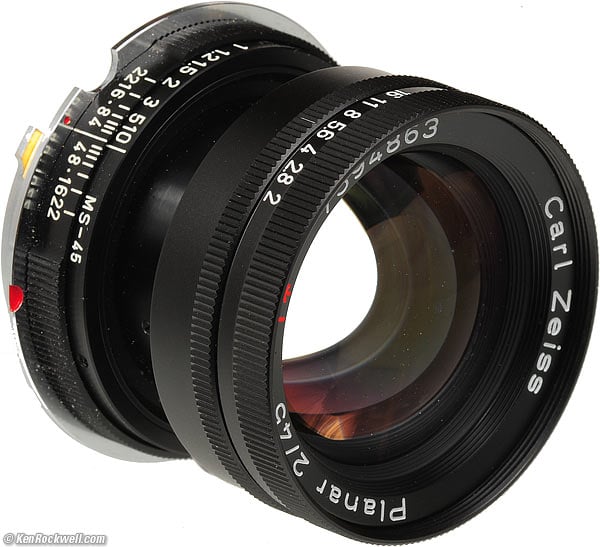
Contax 45mm G converted to Leica M.
45mm Aperture top
It is difficult to set the aperture.
It's just a tiny little ring with a very faint index mark..
You have to hold the rest of the lens so that it doesn't turn in the focus mount as you're trying to turn the aperture ring.
There are no click stops.
Just like the 28mm conversion, the markings are very close together.
It's easy to set a precise aperture on any Leica lens, less easy on a Zeiss-for-Contax lens, and nearly impossible on this conversion.
This could be a big negative if you use an external light meter and need precise settings, but no problem at all if you use a TTL meter as on the M5, LEICA M6, M7 and M8.
45mm Caps top
Standard Leica rear caps work just great.
45mm Optics top
If you want better optical performance, you should be shooting a larger format camera instead. You'll go go blind seeing any difference between these two.
You can see Zeiss' Contax data here and Leica's data here for MTF and distortion curves. I linked to Leica's current 50mm f/2, not my older version seen here.
There is far more ergonomic difference than any optical difference between these lenses.
45mm Sharpness top
I'm not even going to go here. Either of these two lenses is as good as anything ever made for 35mm cameras.
The Contax 45mm f/2 and Leica 50mm f/2 are the two standards against which all other 35mm-format lenses are judged.
45mm Distortion top
The Contax has a little barrel distortion, while the Leica has none.
The Contax 45mm can have just a little visible distortion if you're looking for it. The Leica 50mm f/2 is completely flat by comparison.
45mm Metering top
Metering works perfectly on my M7, as expected. The 45mm lens has no rear protrusions.
45mm Viewfinder Frames top
Whoops! Leicas don't have finders for 45mm lenses, just 50mm lenses.
Since the 45mm sees a little more, I'd pay attention for the first few rolls and correct mentally if you need to compensate for the extra 10% you might get on-film compared to the Leica 50mm.
Both the Leica and Zeiss lenses are actually a couple of millimeters longer in focal length than marked, typically 46.9mm for the Zeiss and 53.2mm for the Leica.
45mm Materials top
Everything seems like anodized aluminum with engraved and filled markings. The mount and helicoid appear to be brass.
Most of the converted mechanicals are more crude than the original lenses. The conversion's edges are usually sharp; not smooth like Leica or Contax.
The mount is chromed brass, and also has had the chrome ground away to expose bare brass at the mounting flange.
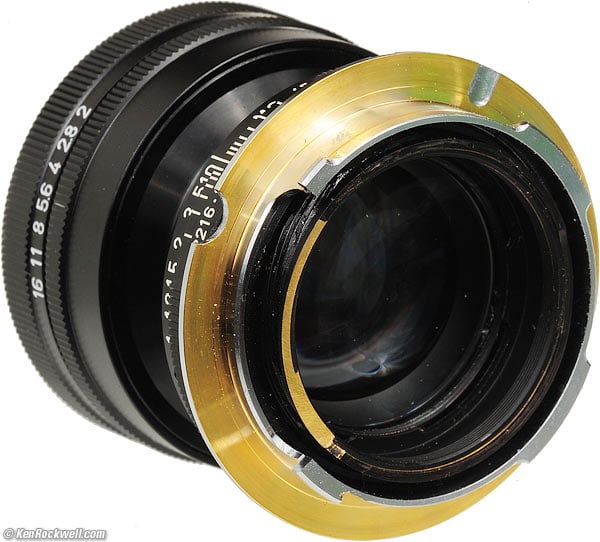
Rear, Contax 45mm G converted to Leica M.
Recommendations top
Intro Specs 28mm Performance 45mm Performance Recommendations
You people know who you are.
I prefer to shoot each lens on its birth camera, but if you want to shoot a Zeiss-for-Contax G lens on your Leica-mount camera, this is the way to do it.
Personally, I never deny myself whatever lenses I want. Money spent on good lenses has always been a great investment. If you want these, get them because they aren't going to go obsolete in 18 months, as do digital cameras.
Even these converted lenses will remain compatible with the Leica system indefinitely. There are no electronics to go obsolete.
More Information
The maker's own web page (where you can order these)
Comparisons among these and other lenses
PLUG
I support my growing family through this website.
If you find this as helpful as a book you might have had to buy or a workshop you may have had to take, feel free to help me continue helping everyone.
If you've gotten your gear through one of my links or helped otherwise, you're family. It's great people like you who allow me to keep adding to this site full-time. Thanks!
If you haven't helped yet, please do, and consider helping me with a gift of $5.00.
The biggest help is when you use any of these links when you get anything. It costs you nothing, and is this site's, and thus my family's, biggest source of support. These places always have the best prices and service, which is why I've used them since before this website existed. I recommend them all personally.
Thanks for reading!
Ken
Home New Search Gallery How-To Books Links Workshops About Contact

